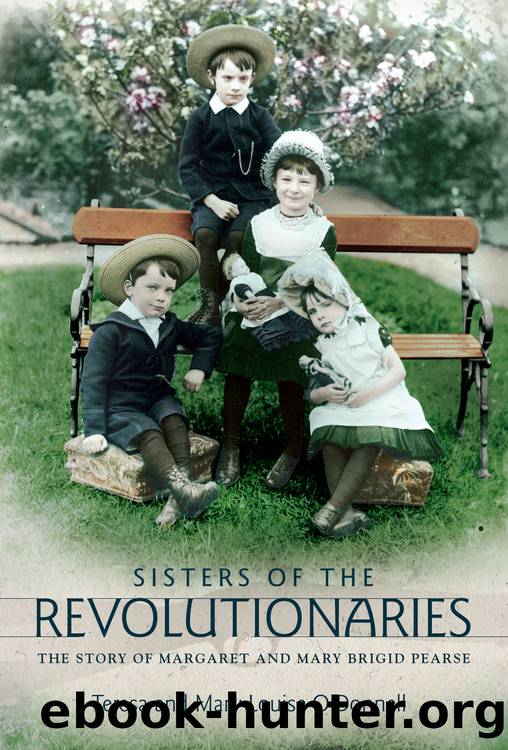Sisters of the Revolutionaries by O'Donnell Teresa;O'Donnell Mary Louise;

Author:O'Donnell, Teresa;O'Donnell, Mary Louise;
Language: eng
Format: epub
ISBN: 9781785371097
Publisher: Merrion Press
Published: 2017-02-23T00:00:00+00:00
CHAPTER 6
Margaret: The Politics of
Being a Pearse
For those of us who had not the privilege of living through those stirring times, to have known Margaret Pearse was the next best thing.1
Unknown
When her mother died in 1932, Margaret Pearse assumed the role of matriarch, honouring the memory of her brothers at State and social events. She succeeded her mother on the Fianna Fáil National Executive and acted as co-treasurer and vice-president. From 1933 to 1937 she was a Fianna Fáil TD for County Dublin, the seat her mother held from 1921 to 1922. In an election campaign speech in 1933, Margaret appealed to her audience to continue to agitate for a united Ireland. She declared:
It is the same old fight ⦠the cause is the same, we have merely changed the tactics. We have the British on the one hand and Ireland and our hope for freedom on the other. There are many men here who were associated with my brothers in the days of the volunteers when you were preparing for 1916. You are now preparing for another fight and this time the way will be easier.2
Margaret was elected to the eighth Dáil, securing the final eighth seat in the constituency with 3,876 first-preference votes.3 One of the first issues Margaret voted on was the removal of the Oath of Allegiance. Under the Anglo-Irish Treaty of 1921, TDs and senators were required to swear allegiance to the Constitution of the Irish Free State and to be faithful to the British sovereign. The Constitution (Removal of Oath) Act was passed on 3 May 1933, seventeen years to the day after Patrickâs execution. Margaret later recalled that after the Act was passed, she went to Ãamon de Valeraâs office to congratulate him and they were both overcome with tears.4 Interestingly, de Valera had no desire to leave the Commonwealth at this point,5 but, in contrast, Margaret was uncompromising in her desire for a united, autonomous Ireland.
On the campaign trail prior to the 1937 general election, Margaret highlighted the achievements of Fianna Fáil during its term in office and its commitment to the creation and expansion of industry. Eight hundred factories were built during the period 1933â7, resulting in increased employment throughout the country. She cited the expansion in the papermaking industry, with new plants at Clondalkin and Saggart, and an increase in the workforce from thirty in 1931, to 200 employees in 1937, as an example of Fianna Fáilâs commitment to developing industry in her own constituency.6 Margaret encouraged women to vote for her, promising that âshe would be the guardian of [their] ⦠rights in the Dáil, if returnedâ.7 She was, however, narrowly defeated in the 1937 general election, receiving 6,204 first-preference votes, a mere 208 votes behind Gerard McGowan (Labour), who won the fifth and final seat.8 Margaret was particularly disappointed that she was not a member of the Dáil when the Constitution of Ireland (Bunreacht na hÃireann) was ratified in December 1937. Nonetheless, after losing in the election, she focused on gaining a seat in Seanad Ãireann.
Download
This site does not store any files on its server. We only index and link to content provided by other sites. Please contact the content providers to delete copyright contents if any and email us, we'll remove relevant links or contents immediately.
Fanny Burney by Claire Harman(26487)
Empire of the Sikhs by Patwant Singh(22909)
Out of India by Michael Foss(16755)
Leonardo da Vinci by Walter Isaacson(13109)
Small Great Things by Jodi Picoult(6871)
The Six Wives Of Henry VIII (WOMEN IN HISTORY) by Fraser Antonia(5360)
The Wind in My Hair by Masih Alinejad(5011)
A Higher Loyalty: Truth, Lies, and Leadership by James Comey(4799)
The Lonely City by Olivia Laing(4708)
The Crown by Robert Lacey(4692)
Millionaire: The Philanderer, Gambler, and Duelist Who Invented Modern Finance by Janet Gleeson(4302)
The Iron Duke by The Iron Duke(4255)
Papillon (English) by Henri Charrière(4149)
Sticky Fingers by Joe Hagan(4068)
Joan of Arc by Mary Gordon(3983)
Alive: The Story of the Andes Survivors by Piers Paul Read(3926)
Stalin by Stephen Kotkin(3828)
Aleister Crowley: The Biography by Tobias Churton(3535)
Ants Among Elephants by Sujatha Gidla(3362)
